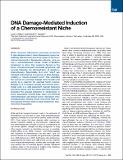| dc.contributor.author | Gilbert, Luke Andrew | |
| dc.contributor.author | Hemann, Michael | |
| dc.date.accessioned | 2015-03-19T14:57:12Z | |
| dc.date.available | 2015-03-19T14:57:12Z | |
| dc.date.issued | 2010-10 | |
| dc.date.submitted | 2010-03 | |
| dc.identifier.issn | 00928674 | |
| dc.identifier.uri | http://hdl.handle.net/1721.1/96076 | |
| dc.description.abstract | While numerous cell-intrinsic processes are known to play decisive roles in chemotherapeutic response, relatively little is known about the impact of the tumor microenvironment on therapeutic outcome. Here, we use a well-established mouse model of Burkitt's lymphoma to show that paracrine factors in the tumor microenvironment modulate lymphoma cell survival following the administration of genotoxic chemotherapy. Specifically, IL-6 and Timp-1 are released in the thymus in response to DNA damage, creating a “chemo-resistant niche” that promotes the survival of a minimal residual tumor burden and serves as a reservoir for eventual tumor relapse. Notably, IL-6 is released acutely from thymic endothelial cells in a p38-dependent manner following genotoxic stress, and this acute secretory response precedes the gradual induction of senescence in tumor-associated stromal cells. Thus, conventional chemotherapies can induce tumor regression while simultaneously eliciting stress responses that protect subsets of tumor cells in select anatomical locations from drug action. | en_US |
| dc.description.sponsorship | National Institutes of Health (U.S.) (NIH RO1 CA128803) | en_US |
| dc.description.sponsorship | David H. Koch Institute for Integrative Cancer Research at MIT (Ludwig Center for Molecular Oncology)) | en_US |
| dc.description.sponsorship | Massachusetts Institute of Technology. Department of Biology (Rita Allen Fellow) | en_US |
| dc.language.iso | en_US | |
| dc.publisher | Elsevier B.V. | en_US |
| dc.relation.isversionof | http://dx.doi.org/10.1016/j.cell.2010.09.043 | en_US |
| dc.rights | Article is made available in accordance with the publisher's policy and may be subject to US copyright law. Please refer to the publisher's site for terms of use. | en_US |
| dc.source | Elsevier | en_US |
| dc.title | DNA Damage-Mediated Induction of a Chemoresistant Niche | en_US |
| dc.type | Article | en_US |
| dc.identifier.citation | Gilbert, Luke A., and Michael T. Hemann. “DNA Damage-Mediated Induction of a Chemoresistant Niche.” Cell 143, no. 3 (October 2010): 355–366. © 2010 Elsevier B.V. | en_US |
| dc.contributor.department | Massachusetts Institute of Technology. Department of Biology | en_US |
| dc.contributor.department | Koch Institute for Integrative Cancer Research at MIT | en_US |
| dc.contributor.mitauthor | Hemann, Michael | en_US |
| dc.contributor.mitauthor | Gilbert, Luke Andrew | en_US |
| dc.relation.journal | Cell | en_US |
| dc.eprint.version | Final published version | en_US |
| dc.type.uri | http://purl.org/eprint/type/JournalArticle | en_US |
| eprint.status | http://purl.org/eprint/status/PeerReviewed | en_US |
| dspace.orderedauthors | Gilbert, Luke A.; Hemann, Michael T. | en_US |
| mit.license | PUBLISHER_POLICY | en_US |
| mit.metadata.status | Complete | |

